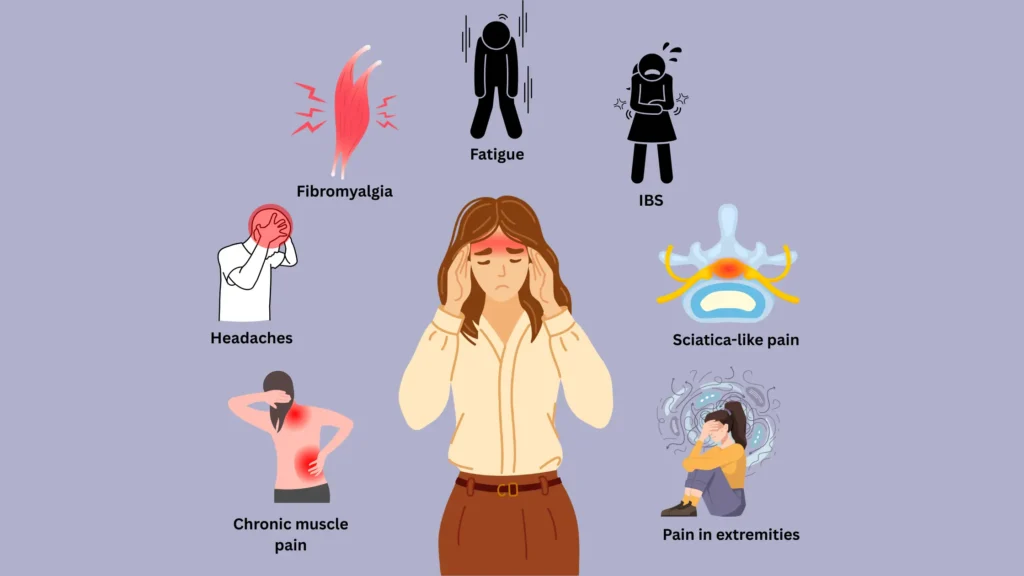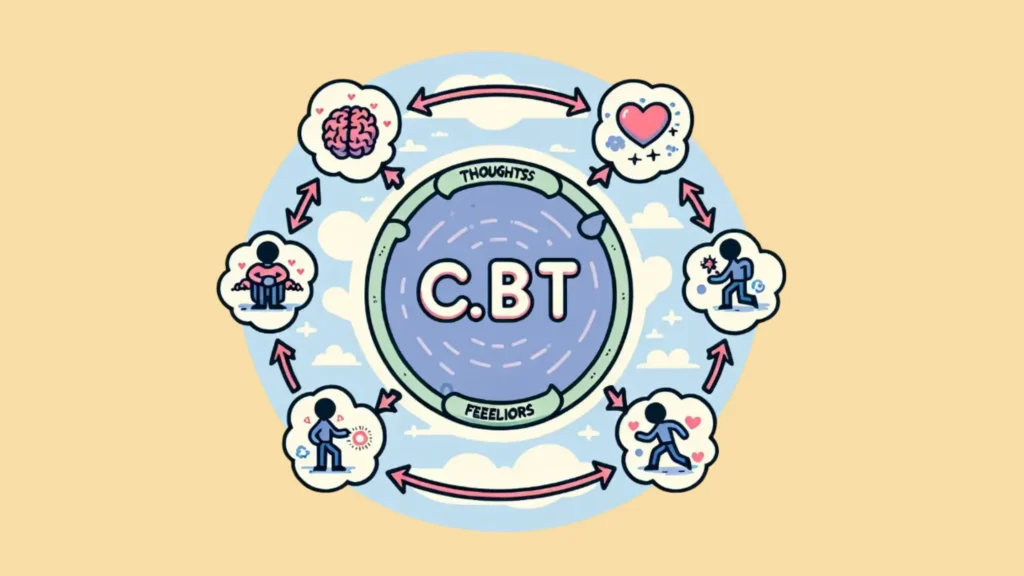Tension Myositis Syndrome (TMS) is a serious disorder that connects emotional stress with the ever-present pain, especially in muscles and joints. TMS is also misdiagnosed since it does not reveal itself in standard medical exams. It is based rather on the knowledge of the fact that the mind-body connection, whereby unbalanced emotions are converted to a bodily state. Parents experiencing TMS or managing it in their children should be aware of how psychological stress could be causing physical pain and the ways to address it effectively.
Table of Contents
- What is Tension Myositis Syndrome?
- What Are the Symptoms of Tension Myositis Syndrome?
- Unique Features of Tension Myositis Syndrome Pain
- The Mind-Body Connection in Tension Myositis Syndrome
- Tension Myositis Syndrome and Anxiety: The Emotional Link
- Treatment for Tension Myositis Syndrome
- How to Find a Tension Myositis Syndrome Therapist
- What to Expect from Tension Myositis Syndrome Therapy
- How These Approaches Work Together for Healing
- Managing Tension Myositis Syndrome in Children
- Tension Myositis Syndrome Forum: Finding Support
- Frequently Asked Questions about Tension Myositis Syndrome
- Conclusion: Healing from Tension Myositis Syndrome
What is Tension Myositis Syndrome?
Introduction to Tension Myositis Syndrome
Tension Myositis Syndrome is a psychosomatic condition where physical pain (especially in the muscles, joints, and back) is caused by emotional or psychological tension. The mind suppresses negative emotions, and these emotions are then reflected in physical symptoms. TMS is most commonly associated with chronic pain conditions like back pain, but it can also cause a variety of other symptoms, including digestive issues, headaches, and fatigue.
Dr. John Sarno’s Role in TMS
TMS was first introduced by Dr. John Sarno, a physician who believed that repressed emotions, especially anger, fear, and anxiety, could manifest as physical pain. His groundbreaking work has helped countless individuals recognize the emotional roots of their chronic pain.
What Are the Symptoms of Tension Myositis Syndrome?

TMS may include mild discomfort and pain. Typical symptoms of TMS are:
- Chronic muscle pain (particularly in the back, neck, and shoulders)
- Headaches, including migraines
- Fibromyalgia or widespread musculoskeletal pain
- Fatigue or exhaustion
- IBS (Irritable Bowel Syndrome) or other gastrointestinal issues
- Sciatica-like pain or numbness
- Pain in extremities (arms, legs, or joints)
Unique Features of Tension Myositis Syndrome Pain
Unlike other types of pain caused by physical injuries or disease, TMS pain can shift locations. It may start in one part of the body and then move to another, which confuses traditional diagnoses and makes it difficult for patients to find lasting relief through conventional treatments.
The Mind-Body Connection in Tension Myositis Syndrome
How Does Emotional Stress Contribute to TMS?
Mind-body relationship is the key to TMS comprehension. When emotional stress has not been resolved, the brain withholds it in an effort to prevent the person from getting into any hard emotions. This emotional repression causes physical muscular and joint tension over the long term. Such tension is responded to by the body itself to form pain as the physical expression of the emotions that it could not express.
Stress and the Nervous System
Whenever we are under stress our sympathetic nervous system gets in to the fight or flight mode. This has the effect of tensing up muscles, breathing superficially and speeding up the heart rate. Constant stress maintains the body functioning in this condition, which results into chronic pain. When this stress and tension do not end up being resolved, TMS occurs.
Tension Myositis Syndrome and Anxiety: The Emotional Link

The Role of Anxiety in TMS
Anxiety is also a big factor in TMS as far as being a symptom and a causative agent of TMS. The fears of chronic pain developing are the major cause of TMS anxiety, which itself can be a contributing factor in the physical symptoms. When an individual develops anxiety concerning their pain, it tends to increase and become hard to deal with. The key issue with respect to TMS treatment is to recognize and address the issue of anxiety.
How Anxiety Affects Muscle Tension
When feeling anxiety, the bodies of people stiffen because the perceived threat provokes their reaction. This physical strain may cause muscle spasm, tension, and backaches in the regions where tension has accumulated like the back and the neck. This is a vicious cycle: as a result of tension, the muscle becomes tense, which increases pain causing anxiety.
Treatment for Tension Myositis Syndrome
Understanding the Treatment Approach for TMS
Mind-body therapies and psychotherapy have proven to be one of the most effective ways of treating TMS. TMS therapists are specialized to assist patients in disengaging and dealing with suppressed emotions that may include anger or fear. Cognitive behavioral therapy (CBT) and mindfulness practices are also employed to regulate emotions and change harmful patterns of thinking.
Psychological Therapies for TMS
One of the best methods of treatment of TMS is psychotherapy especially the mind-body therapies. The role of TMS therapists is to assist patients, to identify and enable the processing of repressed emotions, e.g., fear or anger. Affect or emotions are also addressed using Cognitive behavioral Therapy (CBT) and mindfulness interventions to address the undesirable negative thoughts.
Therapist’s Role in TMS Treatment
A TMS therapist helps one bound them to divulge emotional triggers to their pain. This usually includes discussing former experiences, phobias, or unprocessed emotions that may be presenting themselves in physical form.
How to Find a Tension Myositis Syndrome Therapist

Whenever you suspect that you or a loved one is a victim of TMS, finding the ideal match to a therapist is important. The trained TMS therapist would make you aware of what causes your pain, content-wise, and help you identify the findings in a way of releasing the emotional tension. When choosing a TMS therapist, make sure their knowledge of the psychological side of the problem is deep because the core of the problem lies in the area of emotions.
What to Expect from Tension Myositis Syndrome Therapy
1. Identifying Emotional Triggers for Pain
Identification of emotional triggers that cause physical pain is one of the most important steps in managing the treatment of TMS. Emotional stress or repression seems to be a major problem in most individuals with TMS, and the stress is not always resolved, as it is carried out physically as physical discomfort.
How Does It Work?
- Emotional triggers might refer to previous trauma, relationship problems, ineffable stress at work, or internal turmoil.
- Upon identifying these triggers, the individual is in a position to know how stress builds up and presents itself in the body.
Approach:
- Therapists use techniques such as guided questioning, journaling, or mind-body mapping to help individuals become more aware of their emotional states and identify patterns that lead to pain.
- This is generally carried out in a secure therapeutic environment where they are able to recognize their emotional background and associate it with particular painful areas or regions of the body (the back, the neck, or even the joints).
2. Addressing Repressed Emotions through Therapeutic Dialogue

Anger, frustration, fear or sadness and other such emotions can be repressed, that is to say consciously sought out to avoid or conceal. This is actually part of the unconscious self-defense in relation to all overpowering feelings. But a kind of physical tension, however, may be caused by acted-out feelings, which lead to TMS.
How Does It Work?
- It helps individuals confront and process these emotions in a healthy way. The goal is to allow the person to feel and express emotions that have been suppressed, reducing the emotional pressure that is causing the physical symptoms.
- The repressed emotions can be expressed and worked through the expression of the techniques used by the therapist, like psychodynamic therapy, expressive writing, or talk therapy, among others.
Approach:
- By establishing an environment to help individuals work through and expose these feelings in a safe manner, therapists can help clients work through the emotional healing process.
- This usually consists of reminiscing over earlier experiences or the present situation that elicits emotions. As these emotions are identified and expressed, the body will be in a position to relieve itself of tension and pain that accompanies it.
3. Mindfulness and Relaxation Techniques
Relaxation and mindfulness are also necessary in management of TMS since they provide people with the skills on how to lower both physical and mental tensions. The main idea of these practices lies in paying more attention to what is happening in your mind and heart without judgment and thus disrupting the chain of stress which results in physical suffering.
How Does It Work?
-
Mindfulness helps one be mindful of the moment at hand, which will decrease rumination (repeatedly thinking about what is causing stress) and physical tension.
-
Relaxation techniques include such things as deep breathing, relaxation muscle, and imagery, and are used to activate the parasympathetic nervous system (the rest/digest system) to enable muscle relaxation and to permit one to feel less stressed.
Approach:
Mindfulness practices enable people to be more mindful of the interrelation that exists between their thoughts, feelings, and sensations in the body. Just by seeing these experiences dispassionately, individuals are able to stop emotional upheaval resulting in a physical pain.
Relaxation exercises can help reduce the body’s stress response. This can be done through various techniques such as:
- Deep breathing exercises: Studies have shown that physical tension can be alleviated right away by paying attention to deep breathing.
- Progressive muscle relaxation: Tightening and relaxing various muscles will not only relieve physical stress, but it will also rest the mind.
- Guided imagery: In order to heal, images of calm and relaxing situations should be employed to alleviate stress and enable the body to relax.
4. Cognitive Restructuring to Change Negative Thought Patterns

Cognitive restructuring is a treatment method that strives to modify the negative thinking that leads to stress and pain. This technique is used to identify and replace irrational, harmful, or negative thoughts that may exacerbate TMS symptoms.
How Does It Work?
- Negative thoughts—such as “I can never get better” or “I am always in pain”—can contribute to the cycle of tension and pain in TMS. Cognitive restructuring helps people recognize these thoughts and challenge them.
- The idea is to reframe these negative beliefs by getting them substituted with healthier and realistic opinions.
Approach:
- The most common practice of cognitive restructuring is Cognitive Behavioral Therapy (CBT). It is a process of looking at the pessimistic or skewed thoughts and withdrawing them in favor of more realistic, positive consciousness.
- One could, as an example, exchange a thought such as, “I am weak because I cannot take the pain” with, “The pain does exist, but it is not the result of my being weak.” It is an emotional stress reaction, and it could be controlled.
- In the process one gets to learn to unlink the link that exists between their emotional state and their physical pain, and therefore they end up in a better mental/physical state.
How These Approaches Work Together for Healing

Most of these therapeutic methods act in concert:
- Identifying emotional triggers brings awareness to how unaddressed emotions contribute to TMS.
- Therapeutic dialogue allows individuals to express and process these emotions, reducing their hold on the body.
- Mindfulness and relaxation techniques help individuals cope with current stress and prevent it from escalating into physical pain.
- Cognitive restructuring helps people reframe the negative thought patterns that reinforce the pain cycle, replacing them with more balanced, positive thoughts.
The combination of all these strategies can assist a person in eliminating pain, enhancing emotional well-being and ultimately recovering TMS by focusing on the physical and emotional part of the disease.
Managing Tension Myositis Syndrome in Children
TMS in Children: How It Manifests
TMS can also take place with children just like in any other adult but the only difference is that the signs usually appear in a different manner. Emotional stress may cause children to have back pain, headaches or stomach problems as a result of school issues, family or peer problems. As a caregiver, you should learn to know what the signs of and causes of TMS in a child are.
How to Support Your Child with TMS
- Open Communication: Endeavor to ensure your child understands that it is normal to communicate how they feel and solve emotional distress.
- Create a Calm Environment: Develop an environment of zero stress to enhance emotional comfort.
- Incorporate Relaxation Techniques: Train your child on the use of relaxation measures such as deep breathing and mindfulness so that she can cope with stress.
Tension Myositis Syndrome Forum: Finding Support

Joining a TMS Forum
Any online communities that revolve around TMS may be of great help. Numerous people and parents describe their experience and tips on how to deal with TMS and how to give advice. These forums are there to give emotional support and to answer common questions, in addition to letting you join other individuals who have the same problems.
Why Joining a TMS Forum is Helpful
It is workable and worthwhile to be a member of a TMS Forum and be able to learn, ask, or get encouragement. It may also make you feel like you are not alone in what you have gone through because you are communicating with others who are also suffering secondary to their condition.
Frequently Asked Questions about Tension Myositis Syndrome
1. What causes Tension Myositis Syndrome?
TMS is caused by emotional stress that manifests physically in the muscles and joints. The mind suppresses difficult emotions, which leads to muscle tension and pain.
2. How do you treat Tension Myositis Syndrome?
Treatment for TMS often includes psychological therapies, such as psychotherapy or mindfulness, alongside physical therapy. A TMS therapist helps uncover and process repressed emotions.
3. Can TMS cause anxiety?
TMS anxiety is widespread, yes, because the worry about chronic pain tends to cause further tending, thereby worsening the disease. The TMS treatment involves the management of anxiety.
4. How can I help my child with TMS?
In the case of children, one needs to ensure that they feel safe so that they can be open regarding their emotions. It is possible to encourage relaxation methods and TMS therapy.
Conclusion: Healing from Tension Myositis Syndrome
Tension Myositis Syndrome is not a body condition but an emotional condition. Both parents and children can be relieved through the realization of root causes, and the integration of psychological and physical treatment. TMS is a condition which cannot be cured by refuting just one aspect, whether emotional or physical and with proper aids and equipment, a person can begin to lead a pain free life.
Let’s explore more on Pregnancy Must –
